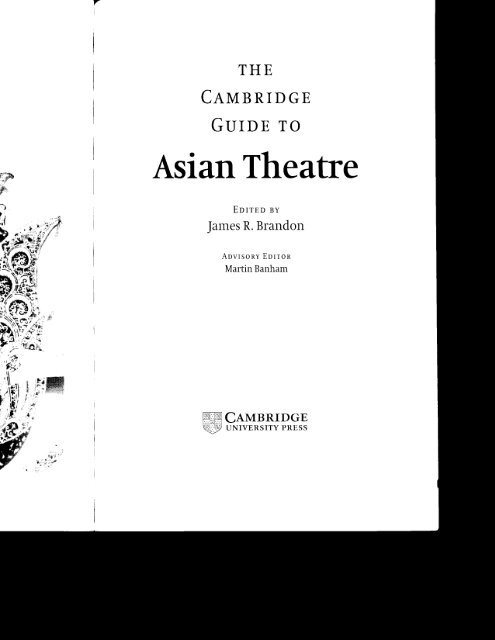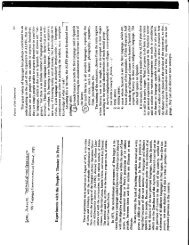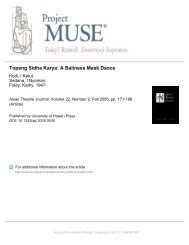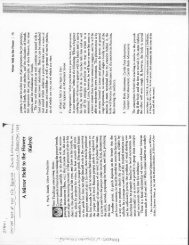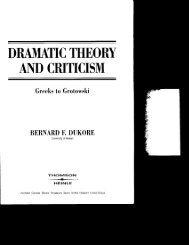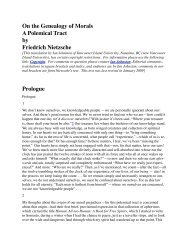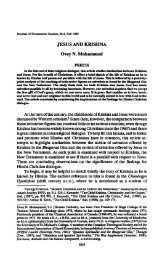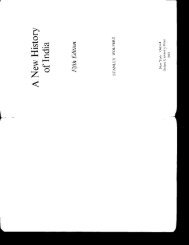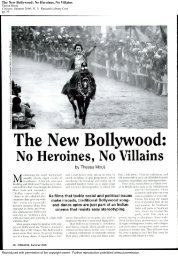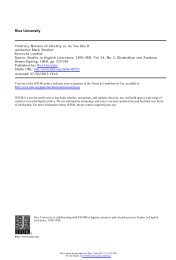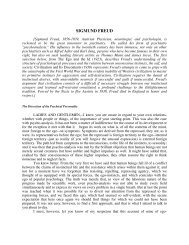Contemporary China - Yavanika
Contemporary China - Yavanika
Contemporary China - Yavanika
Create successful ePaper yourself
Turn your PDF publications into a flip-book with our unique Google optimized e-Paper software.
a<br />
THE<br />
CnMBRIDGE<br />
GUIDE TO<br />
il,;X h<br />
&,<br />
f'<br />
Asian Theatre<br />
Eotrro sv<br />
James R. Brandon<br />
Aovrsonv Eorron<br />
Martin Banham<br />
b<br />
:*j<br />
ii;<br />
..ry'<br />
/<br />
rs<br />
F.E CaMBRTDGE<br />
QP<br />
uNrvERSrrY PRESS
Traditional theatre in the 20th<br />
century<br />
Beijing-stylc theatre colttinuccl to doninatc the<br />
traditional stagc thlough the first halfof the 20th<br />
centr-lry. It retained au unequallcd appeal on a<br />
national scale and had an enormous following<br />
among the ordinary public. This successful transition<br />
in an agc of cultural iconoclasm was possible<br />
because of a particularly talented body of actors.<br />
They bore the artistic integrity ofthc old theatr.ical<br />
tradition forward while adjusting to social change.<br />
A towering figure was Beijing-born Mlr L,wr,eivc.<br />
His artistry and bleadth of perception helped the<br />
old theatrc attain a new pinnacle of public csteenr.<br />
Not thc lcast of Mei's achieventents was his success<br />
in international cultural rclations resrilting frolr]<br />
his touls to Anterica and Russia in the 1930s. Hr.<br />
stirred Western thinking to new aesthetic insights<br />
on theatre. Bertolt Brecht and V. E. Meyer.hold were<br />
anong those who admired, and were dceply influenced<br />
by secing Mei's pelfbrmances.<br />
Two major rcfblms were accontplishcd in thc<br />
professional world of'Mei Lanfang ancl his peers<br />
during the 1920s and 30s. An impr-oved system of'<br />
training and education fbr theatrc appr.enticcs was<br />
introduced and actresses bcgaD to achieve professional<br />
cnancipation. A first attcnpt at inpr.ovcd<br />
training conditions was thc founding in 1903 of<br />
the Xiliancheng (later rcnauted the Fuliancheng)<br />
School in tseijing. Some'of<strong>China</strong>'s greatest Btijing<br />
actors gracluated flom this instrtution. Boys only<br />
werc. acceptcd; admittcd at the age of seven they<br />
were taken on contract for a seven-ycar period.<br />
They lived in. and tuition, board and lodging werc<br />
free. In return, thc school dclnandcd conplcte profcssional<br />
control, including an obligation to perform<br />
in public to fill the school's coflers. It was a<br />
hard lifc demandinq neticr.rlous standards and<br />
intensive application but it represcnted a clear<br />
advance on older nethods when boys could be victimized<br />
by unscrupnlous individuals.<br />
A revolutionary stcp catne in 1930 whcn Li<br />
Yuying fbr-rnded a co-educational conservatory fbr<br />
drarnatic training in Beijing. l'he actor CHTiNG<br />
YlNqru was appointed principal. Cheng was highly<br />
regardecl both fol his stage talents and personal<br />
intesrity. In 1932 Cheng was sent to Europe for a<br />
year on behalf of thc school to study drama and<br />
opera. fhe first of its kind to adnit both sexes on<br />
an equal basis. the school providcd a gcneral edu-<br />
cation siruultaneously with professional training.<br />
An arnbitious syllabus was taught by special tutors.<br />
Profbssionals were in charge ofthcatrical training.<br />
Although only one class graduated, it set the pat<br />
teili that today's training metl]ods fbllow. In 1934<br />
a School fbr lxperimcntal Drana was founded by<br />
Wang Bozheng at Jinan in Shandong. It ainied to<br />
devclop a new national theatre fomr based on traditional<br />
methods whilc dlawing scientifically on<br />
Westeln methods whcn requirecl. A fbur-year<br />
coLrrse was sct up wlth one ycar devotcd to empirical<br />
expcrimeDt. In 1937 all of these scl]ools were<br />
closed by the War ofResistancc against<br />
Japan.<br />
Thc. professional lisc of the actress in the 1920s<br />
and 30s ovcl'cane long{tanding pr.ejudices.<br />
Women were all but exclr-rded fiom the theatre<br />
both as performers and spectators during the 19th<br />
centr.rry.<br />
In the eally 1900s one or two all-wonren<br />
troupes were activc ir) Beijing and Shanghai. They<br />
perfblmed at privatc gatherings ancl were not<br />
allowed into thcatles. By 1920 women wcre per.<br />
folming at sevcral Beijing theatres but never alongside<br />
acto|s. Durir-rg thc 1920s Wang yaoqing<br />
(1881-1954), a teacher of Mci Lanfang, and Mei<br />
himself ignored old prejr.rdices and took female<br />
pttpiJs. a hilheflo rrnLlown l)lr( ricc.<br />
ln 1928 the actressL.s Xue Yanclin (190686) and<br />
Xrn Yanqiu (1911- ) appcarecl on the stagc of the<br />
Cleat Thc.atrc (Da Xiyuan) in Shanghai with male<br />
actors. Froln the age of e.ight Xue had studied<br />
womcn's roles, combat techniques and kunql in<br />
tseijing under Jin Gr.rorui and latcr Zhang Cailin.<br />
From 1930 thror.rgh a long acting career Xue<br />
appearcd regr.rlarly with mixed casts, doing rnuch<br />
to erhancc the theatrical prcstigr. of the actress. In<br />
1960 she assume'd<br />
a tcaching posr with the Bcijing<br />
School of Drarlatic Alt. Xin Yanqiu studied with<br />
Mei Lanfang and Wang Yaoqing. When she began<br />
perfbnning with Cheng Yancliu, she took that<br />
famous actor's plof'cssional narne. Xue and Xin<br />
were thc vanguard of a galaxy of accomplished<br />
won-teu artists who rose to prominence in the<br />
prewaryears and brought new lustre to traditional<br />
tneatre.<br />
The rise of the modern theatre<br />
The 20th century bellan with a movenent to create<br />
a ncw theatrc inspired by Westent exaruple. The<br />
old thcatre bccame a target fbr change. The<br />
Western impact on 1gth-ceutury <strong>China</strong> rcsulted in<br />
many young intellectuals b<br />
study. Thousands went to Jap<br />
modernization had followed<br />
of 1868. Japan was geograp<br />
closer to <strong>China</strong> than the Wes<br />
dition with modernity they fi<br />
tural adjustment easier<br />
returned from Japan became<br />
the early development of mor<br />
In 1907 a Chinese group i<br />
Spring Wiliow Dramatic So<br />
Japanese actor Fujisawa fuaji<br />
school (see Japan. SHTNPA) th<br />
Camille (Chahua nri) by Alex<br />
February 1907. The play app<br />
because the heroine s plight<br />
of their own marital convt<br />
echoed their own social prote<br />
+ A five-act adaptation of I<br />
lowed in June. Entitled The Blt<br />
(Heinu yutian lil) it was staged<br />
in Tokyo where shinpa, a<br />
Japanese genre, was featured<br />
expanded with extraneous<br />
Chinese tastes. A curtain an<br />
elry of effect. Harriet Beec<br />
well received for it offered a r<br />
for protest against racial<br />
which the Chinese too sufferr<br />
Both productions used tra<br />
who first put Shakespeare in<br />
performed by all-male casts<br />
theless offered a substitut<br />
declamation form and the<br />
genre, eventually to be n;<br />
drama.<br />
Shanghai became the ce<br />
ments in the new Western I<br />
Society under Wang Zhong<br />
had studied in Japan, staged<br />
Heaven in 1907. Lu Jingn<br />
returned fiom Japan, organ<br />
Association in 1912. In 1914<br />
Willow Dramatic Society wh<br />
among other productions<br />
theatre. Stage expertise was<br />
and old theatre convention<br />
female impersonation.<br />
'Ihe years 1915-19 mark€<br />
Westerneducated generatio<br />
50<br />
#*'
ith professional training.<br />
s taught by special tutors.<br />
rge of theatrical training.<br />
graduated, it set the pat-<br />
I methods follow. ln 1934<br />
rl Drama was founded by<br />
in Shandong. It ained to<br />
heatre form based on tradrawing<br />
scientifically on<br />
n required. A four-year<br />
re year devotcd to ernpiriall<br />
of these scltools were<br />
stance against Japan.<br />
rfthe actrcss in the 1920s<br />
rngstanding prejudices.<br />
:cluded from the theatre<br />
pectators during the 19th<br />
)0s one or two all-women<br />
:ijing and Shanghai. They<br />
;atherings and were not<br />
y 1920 women wcre perg<br />
theatres br,lt never along-<br />
.e 1920s Wang Yaoqing<br />
of Mei Lanfang, and Mei<br />
judices and took female<br />
wn practlce.<br />
Xue Yanqin {1906-86) and<br />
reared on the stage of the<br />
n) in Shanghai with male<br />
f eight Xue had studied<br />
techniques and kunqr in<br />
ri and later Zhang Cailin.<br />
long acting career Xue<br />
mixed casts, doing much<br />
I prestige of the actress. In<br />
hing post',vith the Beijing<br />
Xin Yanqiu studied with<br />
Yaoqing. \Vhen she began<br />
g YanqiLr, she took that<br />
onal name. Xue and Xin<br />
a galaxy of acconplished<br />
se to prominence in the<br />
rt new lustre to traditional<br />
dern theatre<br />
with a novement to create<br />
by Western exanple. The<br />
target for change. 'lhe<br />
Lrentury <strong>China</strong> resulted in<br />
many young intellcctuals being seut abroad to<br />
study. Thousands went to Japan where progressive<br />
modernization had followed the Meiji Restoration<br />
0f 1868. Japan was geographically and culturally<br />
closer to <strong>China</strong> than the West. lhe synthesis of tradition<br />
with n-rodcrnity they found tht'rc made cultural<br />
adjustment easier. lntellectuals who<br />
returned fron-r Japan bccane a major influence on<br />
the early development of nrodern Chinese theatre.<br />
ln 1907 a Chinese group rn Tokyo founded the<br />
Spring Willow Dramatic Society. Assisted by the<br />
Japanese actor Fujisawa Asajiro, who ran an acting<br />
school (see Japan, sHlNpA), they staged a version of'<br />
CamiIIe \Chahua nri) by Alexandre Dr-rnas Jils in<br />
February 1907. The play appealed to the Chinese<br />
because the heroine's plight rnirlored thc rigidify<br />
of their own narital conventions and suitably<br />
echoed their own social protest.<br />
* A five-act adaptation of Unclc Tom'.s Cobin followed<br />
inJune. Entitled lhc Black Slave's CD, to Ileaven<br />
\Heinu yutian il) it was staged at the Hongo Theatre<br />
in Tokyo where shinpo, an carly westernized<br />
Japanese genle, was fcatured. The play's acttott was<br />
expanded with extraneous interludes to please<br />
Chinese tastes. A curtain and scenery added novelty<br />
of effect. Harrict Beecher Stowc's stoly was<br />
well received fbr it offer-ed a melodramatic vehicle<br />
for protest against racial discrinination from<br />
which the Chinese too suflered.<br />
Both plodnctions used translations by Lin Shu,<br />
who first put Shakespeare into Chinese, and were<br />
performed by all-male casts. Hybrids, they nevertheless<br />
offercd a substittttc Ibr the old songdeclamation<br />
forn and the begilning of a uew<br />
genre, eventually to be named aua1u, spokcn<br />
drama.<br />
Shanghai became the centre tbr early experi<br />
ments in the new Western folm. The Spring Sutt<br />
Society under Wang Zhongshcng (d. 1911), who<br />
had studied in Japan, staged the Black Slcve's Cry to<br />
Heaven rn 1907. Lu Jingruo (1885-1915), also<br />
returned from Japan, organized the New Drana<br />
fusociation in 1912. ln 1914 Lu revived the Spling<br />
Willow Dramatic Sociefy which produced Cunilie,<br />
among other productions, in a comtneLcial<br />
theatre. Stage expertise was slight in thesc years,<br />
and old theatrc conventious lenained, inclltding<br />
female impersonation.<br />
The years 1915-19 narked a tr.rrning point. A<br />
Westerneducated generation was agitating fbr cul'<br />
tural change. lD 1916 the Aurerican-educated<br />
scholar, Hu Shi 11891-1962), spearheadcd a rnovenlent<br />
to rcplace classical language understood<br />
only by an educated elite with a standardized vernacnlar<br />
intelligible to all. New joulnals stlpportlllg<br />
thc New Culturc Movenent prolifcrated. Dranta<br />
ignored by the old literati became recognized as a<br />
mouthpiece for social reform. Neu' Ytruth, a<br />
nlnonthly cdited by Chen Duxiu \1879-1.942),<br />
devoted an issue in 1918 to Henrik Ibsen whose<br />
workwas discussed as an examplc to fbllow. In May<br />
1919 students protested in Beijing against the surrendel<br />
ofChinese sovereignty that was proposcd at<br />
the Palis Peace Conference, and whert the Treaty of<br />
Velsailles fbrmalized the proposals to <strong>China</strong>'s<br />
detriment, national outrage fbrced the Chinese<br />
government to refisc' to sigll. The new intclligentsia<br />
closed ranks in affirming an era ofdcfinitive<br />
cultural change called the Mly 4th Movement.<br />
Succeeding events broltght new impetns to<br />
change in the theatrc. ln 1921 GuJiachen fbr-rndcd<br />
the Shanghai Dranatic Association which became<br />
a fbrceful sponsor of new dratna. Two of its otttstanding<br />
members werc Ouv,tNc Yuqr,lrl and Hong<br />
Shen (1892 1955), stage director-playwrightteacher-film<br />
director. The latter studied in<br />
America fiom 1916 to 1922 and arouscd controversy<br />
ou his t'cturn by lefilsing to cotlntenance<br />
rnen playing women's roles. Endorsed by consewative<br />
public opinion, this convention remained a<br />
barrier to developing a naturalistic actilig style.<br />
Hong Shen defied lolg-standing prejudice by<br />
lecruiting actresses fiom the mole open-ninded<br />
women of the universities and the Shanghai film<br />
world.<br />
In 1921 Ouyang and Hong joined fbrces with<br />
TIAN HAN to fbund the Creatiol Society itt<br />
Shanghai. The first issue of its journal Creotton<br />
Qudrlerlv in 1922, contained Tian Han's playA Nighr<br />
at a Coffcehouse liuJei dian zhi yiye) which became an<br />
inrnrediate theatrical cuuse cilibre. The Society<br />
touled productions throughout thc countty uDtil,<br />
in 1923, it was drssolved by government order.<br />
Although it was short-lived, the Socicty was inflltcntial<br />
in introdr.rcing broad audiences to modern<br />
theatre.<br />
In the 1930s, the Japanest' military threat conlpounded<br />
by the Nationalist Communist political<br />
feud overshadowed intellectual life. Pcople in literature<br />
and the arts lesponded to a new political<br />
k
l--<br />
awareness. In 1931 the League of Left Wing<br />
Dlamatists was fomred. Tian Han and Hong Shen<br />
bccane active mcmbers. Plays wlitten and produced<br />
to portray current political social problems<br />
were vigorously promoted in schools and factories.<br />
The Japancse attack on Shanghai in 1932 intensificd<br />
theatrical protest, to which the Nationalist<br />
government responded with a campaign ofrepression,<br />
forcing leftist theatre underglound. Tian Han<br />
and other League nembers were arrested as a<br />
deterrent.<br />
The Chinese Communist Party (CCP) began organizing<br />
theatre for political action soon after the<br />
party's establishment in 1921. In 1931 the Chinese<br />
Soviet Republic was declared with its capital at<br />
Ruijin. Perfolners werc recruited locally and provided<br />
with dramatic training, political education,<br />
their food, clothing and a subsistence pittance.<br />
Troupes trained at the CCP school in Rr,rijin were<br />
then attached to army units fbr service in rural terlitory<br />
and the front line. This work culminated in<br />
the organization of a Workcrs and Peasants<br />
Dramatic Society. Song, dance and mime were<br />
indispensable to appeal to audiences whose solc<br />
concept of theatre was provided by traditional<br />
opera. An extensive dranatic network firnctioned<br />
on this basis and contributed to establishing a pcrnanent<br />
theatre-training school at the CCP<br />
wartine base in Yan'an.<br />
Advocacy of drama as a factol in social educatlon<br />
was also manifest on the National side. In<br />
1932, Xiong Foxi (1900-65), a plapvright-tcacher'-<br />
producer who had studied theatre in Aurerica, was<br />
invited by the National Association for<br />
Advancement of Mass Education to initiate a<br />
theatre project in the lural district of Dingxian,<br />
Hebei Province. Living among the peasant conlnunity<br />
provided him with authentic material fbr writing<br />
and producing plays with local people as<br />
actors. Within three years the troupe was staging<br />
self-supporting productions which attracted considerable<br />
notice. The Japancse invasion fbrced<br />
Xiong to lead his group to unoccupied west <strong>China</strong>.<br />
There, as the Farmers Resistance Dramatic Corps,<br />
they performed to mass audiences.<br />
Political tensions notwithstandiltg, thc 1930s<br />
witnessed the rise of a socially conscions theatre<br />
given credibility by the con-rn-ritrnent of its plactitroners.<br />
New drarnatists were at work to capitalize<br />
on this advauce, at tines workrng in filln with its<br />
emotive capacity fol evoking human values and<br />
national sel)timent. Tian Han, Ouyang Yuqian and<br />
Hong Shcn all turned to filn as advisers, directors<br />
and scenario writers. A complernentary and continuing<br />
relationship was cstablished between the<br />
modcm stage movement and the film studios. Xia<br />
Yan (1900-95), Japan-returned dramatist and scenario<br />
writer, was representative of this trend. His<br />
nvo early stage plays Under a Shanghar RooJ<br />
(Shanghai n,r,yon xia) and SaiJtnhua were considered<br />
major contributions to the nodern repertoire. The<br />
first portrayed the alienation and suffering oftenenent<br />
dwellers in a grcat city. The second concerned<br />
a celebrated Chinese courtesan, one of<br />
whose alliances was with Count Alfiecl von<br />
Waldersee,<br />
the German commander of the allied<br />
forccs which occupied Beijing to relieve the Boxer<br />
siege in 1900.<br />
Arguably the most important playrv[ight of this<br />
period was Cno Yu, a graduate in Western literaturc<br />
froln a Beijing universiry. His hrst play,<br />
Thuntlerstorm (i.ciyl), directed by Hong Shen and<br />
Ouyang Yuqian in 1935 for the Fr.rdan University<br />
Dramatic Clnb, Shanghai, was an immediate success.<br />
Cao Yu had studied Greek drana and admired<br />
Eugene O'Neill and Anton Chekhov, influences discernible<br />
in this play with its dark commentary on<br />
thc Chinese farnily systen and the social degrada.<br />
tion it cansed. Cledibility of characterization and<br />
rcalistic dialoguc, allied to an intuitive sense of<br />
theatre, stanped this play as a breakthrough for<br />
indigcnous dialogue drana. Cao Yr.r's second play<br />
Srndse (Richa) portrayed the corruptive power of<br />
naterialisn and won him a literary prize.<br />
W lrierness ( Yaanye), M eto m orpho si s lShuibi an), P eking,<br />
Mon ltseijint ren) and forniiy (/ia) followed, establishing<br />
him as a dramatist ofsocial conscience.<br />
Tnunderstornt was taken throughout the country<br />
by Thc <strong>China</strong> Travelling Dr-arnatic Troupe, founded<br />
in Shanghai in 1934 by Tang Huaiqiu. His goal was<br />
a modern repertory theatre on a financially viable<br />
basis. A co-operative unit, they achieved a homogeneous<br />
quality in their acting. Thtnderstorm broke<br />
all box-office records for modern theatre and this<br />
was followed by Hong Shen's equally successful<br />
Lady Wind.ermere's lan. The troupe's aim seemed<br />
close to realization when in 1937 waf intervened.<br />
Thcy moved their basc to Hong Kong fbr a brief<br />
period, but that too fell to the Japanese at the end<br />
of 1941.<br />
In Decernber 1937 rheau<br />
Tian Han, mer in Hankou to t<br />
Dramatic Associrtion to R<br />
umbrella fol all warrime th<br />
February 1938 Tian Han be<br />
governtrrent's Cultural Work<br />
of the Propaganda Section, a<br />
ship was rpplied to all<br />
Henceforward nrodern lheat<br />
to national propaganda need<br />
united theatre people as neve<br />
vocation. they responded wi<br />
to take propagandist theatre<br />
Nationalists and Communis<br />
concept ifwith divergent idec<br />
The rapid advrnce of rhe it<br />
the Nationalisr governmenrt<br />
at Chongqing. Sichuan Prov<br />
major cducarional organiza<br />
together with those prominen<br />
arts. Thc emorional cilmale<br />
manifesro ot Xiong Foxi for hi<br />
west <strong>China</strong>: 'Cultivate mod<br />
artisl's passion and a soldi<br />
<strong>China</strong>'s spiritual regeneratio<br />
Students of the co-educati<br />
Acadenry of Dramatic fur, fr<br />
evacuated to chongqing, ma<br />
debut staging streer plays and<br />
A favoured technique entailed<br />
entering teahouses and drat<br />
seemingly spontaneous dia<br />
affairs. Lack of pernranents<br />
equlpment in wartime territc<br />
hundreds of itinerant troupe<br />
erary nren frequenrly joined<br />
sionals. Urban intellectuals a<br />
tion shared a new direct relat<br />
of dramatic activities.<br />
Tian Han, official spokes<br />
wartime, encouraged these tre<br />
tenl for lhe future. He adap<br />
Beijing-opera favourites as Th<br />
zhuan) for nodern productio<br />
time, his version becanre sla<br />
Ouyang Yuqian worhed clos<br />
during those years, leading a<br />
patriotic plays. Hong Shen rar<br />
and taught film lnd drama ir<br />
was a time of shared skills and<br />
3B<br />
;'
evoking human values and<br />
an Han, Ouyang Yuqian and<br />
to film as advisers, directors<br />
A complementary and con-<br />
,tas established benveen the<br />
:nt and the hhn studios. Xia<br />
'eturned dramatist and sceesentative<br />
of this trend. His<br />
ys Undcr a Shanghai RooJ<br />
d SaiJinhua were considered<br />
r the modern repertoire. The<br />
nation and suffering oftene-<br />
[eat city. The second con-<br />
Chinese courtesan, one of<br />
with Count Alfred von<br />
n conmander of the allied<br />
Beijing to relieve the Boxer<br />
mportant playwright of this<br />
graduate in Western literauniversify.<br />
His first play,<br />
irected by Hong Shen and<br />
|5 for the Fudan University<br />
hai, was an immediate sucd<br />
Greek drama and admired<br />
ton Chekhov, influences disith<br />
its dark connentary on<br />
tem and the social degradality<br />
of characterization and<br />
ed to an intuitive sense of<br />
play as a breakthrough for<br />
rama. Cao Yu's second play<br />
rd the corruptive power of<br />
rn him a literary prize.<br />
tamuyhosis lShuibian), Peking<br />
mily (Jia) followed, establishofsocial<br />
conscience.<br />
(en throughout the country<br />
g Dramatic Troupe, founded<br />
'Tang Huaiqiu. His goal was<br />
eatre on a financially viable<br />
rit, they achieved a homogeacting.<br />
Ihunderstorm broke<br />
br modeln theatre and this<br />
; Shen's eqr.rally successful<br />
The troupe's aim seemed<br />
ren in 1937 war intervened.<br />
e to Hong Kong for a brief<br />
ll to theJapanese at the end<br />
ln Decernber 1937 theatrc leaders, including<br />
Tian Han, tnet in Hankou to organize the National<br />
Dramatic Association to Resist the Eneny, an<br />
umbrella for all wartime theatrical activities. In<br />
February 1938 Tian Han became director of the<br />
government's Cultural Work Committee and head<br />
of the Propaganda Section, iind a zealous censorship<br />
was applied to all dramatic activify.<br />
Henceforward modern theatre was subordinated<br />
to national propaganda needs. A call fbr resistance<br />
united theatre people as never befbre. Itinerant by<br />
vocation, they responded with travelling troupes<br />
to take propagaDdist theatre to the lulal masses.<br />
Nationalists and Communists sharecl il conmon<br />
concepr ifwith divelgent ideological intent.<br />
The rapid advance of the invading fbrces drove<br />
the Nationalist government to set up their capital<br />
at Chongqing, Sichuan Province. Universities and<br />
major educational organizations followed then,<br />
together with those proninent in every field of the<br />
arts. The emotional climate was typified by thc<br />
manifesto ofXiong Foxi for his theatre students in<br />
west <strong>China</strong>: 'Cultivate modern drama with an<br />
artist's passion and a soldier's discipline to aid<br />
<strong>China</strong>'s spiritual regeneration.<br />
Students of the co-educational Nanjing National<br />
Academy of Dramatic Art, founded in 1935 and<br />
evacuated to Chongqing, made their professional<br />
debut staging stleet plays and'living newspapers'.<br />
A favoured technique entailed actors anonymously<br />
entering teahouses and drawing an audience by<br />
seemingly spontaneous dialogues on current<br />
affairs. Lack of pennanent stages and technical<br />
equipment in wartime territory did not deter the<br />
hundreds of itinerant troupes. Academics and literary<br />
nen frequently joined forces with professionals.<br />
Urban intellectuals and the rural population<br />
shared a new direct relationship as the result<br />
of dramatic activities.<br />
Tian Han, official spokesman fbr theatre in<br />
wartime, encouraged these trends as a healthy portent<br />
for the future. He adapted such traditional<br />
Beijing-opera favourites as The \4&ite Snake (Boishc<br />
zhuan) for modern production. Criticized at the<br />
time, his version became standard after the war.<br />
Ouyang Yuqian worked closely with Tian Han<br />
during those years, leading a troupe that toured<br />
patriotic plays. Hong Shen ran a theatrical troupe<br />
and taught hlm and drama in the universities. It<br />
was a time of shared skills and commitnents.<br />
Xia Yan's plays successfully car.rghthe public's<br />
mood. Typical was City oJSorrols (Chouchengji) satirizing<br />
life in Japanese-occupicd tclritory. Put down<br />
Your Wry (lang,xia nide btanzi) denounced Japanese<br />
aggression and was outstanding among the mass<br />
of propaganda pieces being produced. Cao Yu, in<br />
contrast, wrote nothing after his adaptation in<br />
1941 of Ba Jin's novel Fanrily. Xiong Foxi became<br />
disillusioned with governmcnt ccnsorship policy<br />
after serving as head of the Sichuan Provincial<br />
College of Dramatic Arts. He left for Guilin in the<br />
southwest where he engaged in writing and editorial<br />
work until 1945.<br />
Wartine Chongqing saw the germination of a<br />
national dance movement resulting fiom the wolk<br />
of Dai Ailian (1916 ), a Tlinidad-born Chinese<br />
danseuse. Aftcr studying ballet in lngland, patriotic<br />
motives led hcr to wartime <strong>China</strong>. While teaching<br />
in Chongqing she began studying local folk and<br />
minority nationality dances. With a team of pr.rpil<br />
assistanls she travelled to outlying areas researching<br />
and notating choreographic techniques, evcntually<br />
forming her owu conpany. Her pioneering<br />
work then prepared the way fbr organized dance<br />
educatior.r in <strong>China</strong> later.<br />
The tangential ingredients of narrative, solrg<br />
and descriptive gesture in folk dance embodied<br />
primal elemcnts of Chinesc theatrical comnunication.<br />
They appealed directly to the uncomplicated<br />
emotive responses of peasant audiences. Both<br />
Nationalists and Cor.nnunists sought to profit<br />
frorn this factor in their wartine sensitivity to fblk<br />
tradition. The Communists were the more uncompromising.<br />
The artistic criteria of folk genres were<br />
subordinated to theories ofproletarian drama created<br />
to eliminate the aesthetic 'elitisrn' of the old<br />
theatre.<br />
Following the Long March of 1934-5 the<br />
Cornmunists set up their base in the loessic caves<br />
at Yan'an in northern Shaanxi Province. Thele in<br />
May 1942 Mao Zedong gave his 'Talks at the Yan'an<br />
Forum on Literature and Art'. In them he<br />
expounded his Marxist manifesto destined to<br />
become the bible of all Chinese cultural endeavour.<br />
He spoke at the Lri Xun Art lnstitute which<br />
trained troupes to adapt old folk-perfornance<br />
methods to new content.<br />
One such ancient form nuch utilized by the<br />
Comnunists was the l,angge rice-planting song.<br />
Originally-yangge referred to simple rhythmic steps<br />
39
fut:"l<br />
danced to a chant and percussion while planting<br />
the rice helds. \Vhen Communist troops entered<br />
the big cities in 1949 they were preceded by frles of<br />
dancers performing this simple work forn as a victory<br />
theme. In time yangge was applied collectively<br />
to various other types of performances that were<br />
rlpvolnrrarl frnm it<br />
During the 19th century the style of yongge<br />
prevalent in Dingxian, Hebei Province, gradually<br />
became elaborated as village perfbrnrance: 20 to 30<br />
dancers perfbrmed with a leader, male and female<br />
characters confronted each other with a question<br />
-response narrative followed by singing and dance<br />
movements extended with representational gesture.<br />
Elemental themes from village life and ethics<br />
wele introduced. A cornic character fiequently<br />
added the necessary touch of earthy humour.<br />
Drum, gong, flute and rymbals plovided musical<br />
,. ^ ^^ - -,. - : -.- ^ - L<br />
dLLUt r I Pdl<br />
lll llEll L,<br />
Two scholars, Li Jinghuan and Zhang Shiwen,<br />
conducted a governnent-sponsored freld project<br />
on the Dingxian style in 1932, afterwards publishing<br />
an anthology of plays. It was this genre of performance<br />
the Communists for.rnd so adaptable and<br />
were quick to develop for their needs. Yangge<br />
troupes proliferated. More than 30 ofthem staged<br />
performances at the 1944 Yan'an spring festival.<br />
Their repertoire included a play called The Wite-<br />
Haired CirI lBaimao nii l.<br />
Reputedly of ballad-recitative origin and based<br />
on some actual facts, the play had undergone collective<br />
revisions prior to the 1944 presentation. In<br />
1945 a new five-act version was prepared with a<br />
script and lyrics by He Jingzhr 17924- ) and Ding Yi<br />
(1,921,-). Music based on authentic folk sources<br />
was composed for it by Ma Ke (1918-76) and five<br />
colleagues. Being directed against abusive social<br />
practices long familiar to village tenant farmers, it<br />
becane a theatrical symbol of the revolutionaly<br />
cause and was constantly performed in the late<br />
1940s and 1950s. The fusion ofsong, music, chorus<br />
work and ordinary speech allied to a contemporary<br />
setting set The V\htte-HaLrcd Giri apart from either<br />
traditional Chinese or modern Western stage practices,<br />
though both had clearly offered son're inspiration.<br />
[t appealed to an audience fbr whom<br />
theatre without song and music was inconceivable<br />
and dialogue drama in the Western vcin meaningless<br />
in the context of their lifestyle.TheWtttHoired<br />
Girl was the first full-length representative ofa new<br />
40<br />
national genre naned cUU, song drama. Flexible<br />
in subject matter and musical form it was contenpolary<br />
but adaptable to regional traditions. lt was<br />
one solution to finding a middle way befween past<br />
and present, a long-standing problem of Chinese<br />
theatre.<br />
Re-establishrnent of the Nationalist capital at<br />
Nanjing in May 1946 followed Japan's defeat in<br />
1945. ln 1946 full-scale civil war broke out as the<br />
CCP began its drive for ultirnate power. Crippling<br />
inflation Ied to economic chaos and social disintegration.<br />
The plight of the universities was desperate,<br />
the mood ofintellectuals despair.<br />
In 1946 Xiong Foxi became head of the Shanghai<br />
Municipal Experimental School of Dranatic Art.<br />
Sharing the premises of a local rnuseurn and pri<br />
rnary school. Xiong's faith in theatre was natched<br />
by that ofhis students and stafI. Conbining classroom<br />
study with working experience they sustained<br />
a continuing series ofperfbrmances for the<br />
public in spite of neglible government support.<br />
Tian Han, Cao Yu and Hong Shen all taught there<br />
after the war. Xia Yen had given up playrvriting for<br />
filn wolk and Ouyang Yuqian was working fbr<br />
Hong Kong film studios. Dai Ailian, the dancer,<br />
another guest of the United States during this<br />
period, returned to set up her own school in<br />
Shanghai. ln 1949 when the Nationalist governnent<br />
left for Taiwan these key artists stayed on to<br />
work under the new governnent. It was a decision<br />
which was shared by a large proportion of people<br />
prominent in both traditional and modern theatre<br />
circles.<br />
The People's Republic 1949-91: policy<br />
and theory<br />
On 1 October 1949 the Chinese Comnunist Party<br />
(CCP) established the People's Republic of <strong>China</strong><br />
{PRC)under its Chairman Mao Zedong. In 1966 Mao<br />
Iaunched his radical Cultural Revolution in an<br />
attempt to preserve revolutionary purify. With his<br />
death in September 1976 and the fall ofthe radical<br />
'gang olfour' the following month, economic modernization<br />
soon assumed top priority in <strong>China</strong>'s<br />
poliry, and in 1981 both the Cultural Revolution<br />
and Mao's leadership from 1958 on were largely<br />
discredited.<br />
Attitudes towards theatre reflect overall CCP<br />
policy, which means that thefe have been substantial<br />
changes from period to period. However, at no<br />
tine has rhe CCp believed it<br />
cern with theatre activities al<br />
the fact of censorship has br<br />
though the extent has varied (<br />
Until 1981, the basic CCp I<br />
theatre (and other arts) were<br />
in his'Talks at the yan'an ton<br />
Art'. Mao declared there thar L<br />
ety but also influenced it as<br />
ganda, whether it intended t(<br />
theatre as representing the int<br />
another and advocated that i<br />
bourgeoisie and favour the<br />
peasants and soldiers. Elsewh<br />
the critical assimilation ofrra,<br />
theatres.<br />
In July 1950 the new gover<br />
Culture set up a Drama Re<br />
determine precisely how pra<br />
should be brought into line I<br />
traditional music dramas it re<br />
emphasized Chinese patriotis<br />
or heroism, equality betwee<br />
political prominence of womt<br />
drarnas on historical themes<br />
emphasize similar topics. On th<br />
items considered 'feudal'and r<br />
agalnst the poor were banned<br />
isms, costunes and other aspe<br />
actor's craft were retained, ref<br />
abolition of some 'unhealthy, r<br />
hero should be shown in a pos<br />
ated him before a feudal pers<br />
Kowtowing and the 'false foc<br />
Changsheng were banned. Ther<br />
of 1958 gave strong emphas<br />
forms on contemporary them(<br />
courage traditional themes. Th<br />
and early 1960s, although<br />
Stanislavski were donrinant in<br />
cles, those of Bertott Brecht als<br />
led by Huang Zuoling ofthe Sh<br />
Theatre.<br />
At a meeting of heads of CC<br />
held in April 1963, Mao's wifeJi<br />
cular distributed calling for ,thr<br />
performance of ghost plays', by<br />
any traditional nusic drama r<br />
historical item. ln mid 1964 a<br />
Opera on <strong>Contemporary</strong> Then<br />
ffi$#;lri 1
EJU, song drama. Flexible<br />
rsical form it was contem-<br />
:egional traditions. It was<br />
middle way between past<br />
ding problem of Chinese<br />
he Nationalist capital at<br />
,llowed Japan's defeat in<br />
:ivil war broke out as the<br />
rltimate power. Crippling<br />
: chaos and social disintee<br />
universities was desperuals<br />
despair.<br />
ame head ofthe Shanghai<br />
School of Dramatic Art.<br />
a local museum and pri<br />
h in theatre was matched<br />
nd stafl Combining class-<br />
Lng experience they susls<br />
of performances for the<br />
ble government support.<br />
lng Shen all taught there<br />
l given up plapvriting for<br />
Yuqian was working for<br />
. Dai Ailian, the dancer,<br />
nited States during this<br />
up her own school in<br />
I the Nationalist governse<br />
key artists stayed on to<br />
rrnment. It was a decision<br />
irge proportion of people<br />
ional and modern theatre<br />
rlic 1949-91: policy<br />
lhinese Conmunist Party<br />
rople's Republic of <strong>China</strong><br />
L Mao Zedong. In 1966 Mao<br />
rltural Revolution in an<br />
Iutionary purity. With his<br />
and the fall of the radical<br />
ng month, economic modd<br />
top prioriry in <strong>China</strong>'s<br />
r the Cultural Revolution<br />
om 1958 on were largely<br />
eatre reflect overall CCP<br />
t there have been substanto<br />
period. However, at no<br />
time has the CCP believed it should relax its concern<br />
with theatre activities altogether. As a result,<br />
the fact of censolship has been conslstent, even<br />
though the extent has varied enormously.<br />
Until 1981, the basic CCP policy and theory of<br />
theatre (and other arts) were those Mao advanced<br />
in his'Talks at the Yan'an Forum on Literature and<br />
Art'. Mao declared there that theatre reflected society<br />
but also influenced it as a means of propaganda,<br />
whether it intended to or not. He held all<br />
theatre as representing the interests ofone class or<br />
another and advocated that it should oppose the<br />
bourgeoisie and favour the masses of workers,<br />
peasants and soldiers. Elsewhere, Mao pushecl for<br />
the critical assimilation oftraditional and foreign<br />
theatres.<br />
In July 1950 the new governmcnt's Ministry of<br />
Culture set up a Drama Reform Committee to<br />
determine precisely how practice in the theatre<br />
should be brought into line with theory. Anong<br />
traditional music dramas it retained those which<br />
emphasized Chinese patliotisrrl, peasant rebellion<br />
or heroism, equality between the sexes, or the<br />
political prominence of women. Newly arranged<br />
dramas on historical themes were expected to<br />
emphasize similar topics. On the other hand, many<br />
items considered<br />
'feudal' and siding with the rich<br />
againsthe poor were banned. \\hile the tnannerisms,<br />
costun-tes and other aspects ofthe traditional<br />
actor's craft were retained, reform demanded the<br />
abolition of sone'unhealthy' usages. No people's<br />
hero should be shown in a position which humiliated<br />
him before a feudal person such as a monk.<br />
Kowtowing and the 'false foot' devised by Wei<br />
Changsheng werc banned. lhe Great Leap Forward<br />
of 1958 gave strong emphasis to dranas of all<br />
forms on contemporary thernes, but did not disc0ufage<br />
traditional themes. Throughout the 1950s<br />
and early 1960s, although the theolies of<br />
Stanislavski were dominant in spoken-drama circles,<br />
those of Bertolt Brecht also had a following,<br />
led by Huang Zuoling of the Shanghai People's fut<br />
Theatre.<br />
At a meeting of heads of CCP Cultural Bureaux<br />
held in April 1963, Mao's wif'e Jiang Qing had a circular<br />
distributed calling for'the suspension ofthe<br />
pertbrmance of ghost plays', by which she meant<br />
any traditional nusic drama or newly arranged<br />
historical item. ln rnid 1964 a Festival of tseijing<br />
Opera on <strong>Contemporary</strong> Themes was held, sig-<br />
nalling the near total disappearance of all such<br />
'ghost plays' fi-on the stage for 13 years. In<br />
February 1966 Jiang Qing hcld a forum on<br />
'Literature and Art in the Armed Forces'which laid<br />
down the line on theatre demanded dr.rring the<br />
Cultural Revolution 11966-76). It followed Mao's<br />
ideas closely in its enphasrs on class and class<br />
strugglc and the mass linc, but placcd an extrenle<br />
interpletation on thelrr.'lhus'clitical assin-rilation'<br />
of tradition meant retention oi little nlore than the<br />
name Beijing opera. All content mr.lst praise the<br />
revolr.rtion and the CCP directly, almost all the tr.aditional<br />
content, mannerisns and costumes were<br />
banncd as espousing feudal ideas and class interests.<br />
The Forun also pushed the notion ofa 'n-rodel'<br />
drama, one which encapsulated perfectly all the<br />
Cultural Revolution's theory of theatrc. Over the<br />
following ycars a small number of these 'n-rodels'<br />
was devised, and professional drama companies<br />
wele allowed to perform more or less nothing else.<br />
One of the main featurcs of the 'models' was their<br />
characterization, which portrayed the heroes as<br />
faultlcss, and the villains as without redeeming<br />
teatures.<br />
Jiang Qing was the leader of the 'gang of four'<br />
and it was not long after theil fall that thc Cultural<br />
Rcvolrition's theatre theorywas discredited. In May<br />
1977 several scenes<br />
ofa newly arranged histolical<br />
drama were restagcd in Beijing. Early the following<br />
year the main power-holder ol the new leadelship,<br />
Deng Xiaoping, gave explicit approval for the<br />
revival of traditional music dramas and these<br />
began to trickle baclt, very quickly becoming a vcritable<br />
torrent rvhich, as of the rnid-90s, shows no<br />
signs of subsiding. Love-stories and patriotic<br />
dramas, as well as those about peasant rebels,<br />
again reccived encouragemcnt and the themc of<br />
rightcd injustice sct in the dynastic pasr becante a<br />
useful propaganda weapon on behalf of lcgal<br />
reform. Hunour again becane a don-rinant part of<br />
the Chinese legional drama, and entertainment<br />
was accepted as a nain purpose oftheatre.<br />
The main linchpin in the CCP's theatre policy is<br />
the need for variety. The range of forn and content<br />
continucd to broaden until 1989, on the whole<br />
with CCP approval. Up till 1989 attempts to hold<br />
back this trend towards liberalization, sucli as the<br />
Campaign against Spilitual Pollution in 1983,<br />
proved shortJived. In 1982 Mao's 'Talks at the<br />
Yan'an Forurn'were partly discredited. ln theory,<br />
: i<br />
&<br />
4l
theatre should still serve the interests of the<br />
'people'but the emphasis on its use as a propaganda<br />
we:ipon fbr socialism teuded increasingly to<br />
weaken. As a result, modern dramas ignoring the<br />
role ofthe CCP in sociefy, and those advocating no<br />
solution for its ills, became common. Psychological<br />
drana becane popular aurong the urban intelligentsia.<br />
Thc theories of acting and theatre of<br />
Bertolt Brecht increased in influence especially<br />
among younger play"rvrights. Since 1979 valious<br />
forms of foreign theatrc have received CCP sponsorship,<br />
not only petfoltned by foreign companies<br />
in the original language, but also by local troupes<br />
and translated into Chinese.<br />
The crisis of 1989, which clinaxed in the bloody<br />
Tiananmen Square incident in Beijing on 4 June,<br />
exercised a highly detrinental effect on modern<br />
forms of drama because it placed a clamp on new<br />
experiments aDd ideas in theatre which conld be<br />
construed as non-supportive of the CCP. In the<br />
period following the crisis, the man with chief<br />
responsibility for literature and thc arts was Li<br />
Ruihuan. ln a najor speech made on 10 January<br />
1990 he emphasized the magnificencc of Chincse<br />
tradition and called for the critical absorption of<br />
foreign cultures. He summalized the relationship<br />
between art and politics as follows: 'We do not<br />
require literature and art to be directly subordinate<br />
to temporary and specific political tasks. At<br />
the sane time, this does not mean that literature<br />
and art can deviate flon sewing socialisur.'<br />
Certainly there would be no return to the policies<br />
ofthe Cultural Revolntion, when literature and art<br />
were indeed directly subservient to political tasks.<br />
At the same time, Li's position implied a strol)g<br />
tendency to glori$ the Chinese'nation' through<br />
theatre and other arts.<br />
As a result government support for traditional<br />
ntusic drama and plays set in the distant past grew<br />
noticeably at the expense of those dramas or<br />
drama folns fbcused on modcrn history or<br />
contemporary society. In 1990, the 2001h anniversary<br />
of the entry of the Anhui companics into<br />
Beijing in 1790, a major stage along the parh<br />
of dcveloprncnt of the Beijing opera, was celebrated<br />
enthusiastically tluoughout <strong>China</strong>. By<br />
way of climax, a festival fbaturing traditional<br />
nusic dramas was held in Beijing attended<br />
by Li Ruihuan and Jiang Zenin, CCP Secretary-<br />
Ceneral.<br />
Form, performance<br />
The main forrns of theatrc in <strong>China</strong> since 1949 are<br />
tfaditional nusic drama, newly alranged historical<br />
drama lxrrrrarv ilsHr lu), spoken drama (haojl),<br />
song drama (gciil), dance dlarra (wu7u) and ballet,<br />
There are abour 350 r'egional sfyles of traditional<br />
music drama, as explained in thc sections on impe<br />
lial <strong>China</strong>.'flre content is always from the distant<br />
past. As in the past, stage properties are simple,<br />
thele is no sccnety, btlt costulnes and makeup are<br />
elaborate, nannerisns, posture and body move<br />
ments stylized. An cvening's entertainnent will<br />
normally feature three or four sholt items. Reform<br />
and censorship have removed certain items and<br />
passagcs, but this is the forn least affected by the<br />
modern age. 'Newly arranged histolical dramas'<br />
are traditional in nost aspccts of style, but as the<br />
nane sugliests, arc created by contenporary writ.<br />
ers and perfbrmers. ln addition, scores ofamateul<br />
and professional puppetry tror.rpes perpetuate vari.<br />
ous resional traditions of puppet play (kuilei ri),<br />
shadow play (piltng xt), and rod-puppet play \zhang.<br />
to u kuilei) perform ance.<br />
fulong Westernizcd forms, the trrost inportant<br />
is spoken dran-ra (hlaju). Only ofthis forn can itbe<br />
said, in the 1980s, that most items are set in the<br />
present or even srnce 1949. The best representative<br />
writer before the Cultural Revolution was Lao SuE.<br />
Spoken drama in thc 1980s showed invcntiveness<br />
and innovation and the nost outside, nainly<br />
Western, influence. Social commentary remained<br />
strong, but arrlong avant-garde play.uvrights, propa.<br />
ganda ofthe fype favouled by the CCP became less<br />
and less direct, more and mole subdued.<br />
Individualism and feminisn are hallmarks of con.<br />
tenporary female playwrights snch as tsai Fengxi<br />
(1934- ). Directors have experintented with tech.<br />
nlques new to <strong>China</strong>, fbr example, variation in the<br />
colour and intensity of stageJighting to show emotional<br />
or psychological atmospheres or qualities.<br />
Spoken dramas of the PRC normally use elaborate<br />
scenery and stage properties and in urban theatres<br />
the act curtain is dlawn to ntark beginning, end or<br />
intermission. Howcver, since 1982, a few plays<br />
have adopted extremely sintple stage properties,<br />
and abandoned scencry and the curtain altogether.<br />
Body movements and postures are realistic, not<br />
stylized as in traditional ntusic drama. But whereas<br />
the plays with hear,y propaganda content tended<br />
to show ideal characters through rather stilted,<br />
e\ren stereoq?lcal, movem<br />
ral style became more PoP<br />
tray characters who ther<br />
images laid down as good<br />
ccP.<br />
The introduction ofwe<br />
pally to Soviet influence. I<br />
mainly items of classic<br />
especiallY Swan Lake' The<br />
Qlng included two ballets<br />
The Red Detachment oJ Wo<br />
Since 1976, these items h:<br />
and classical works hav<br />
time, Chinese artists art<br />
steps towards creating tl<br />
including comPoslng nr<br />
ballet dancers. However<br />
to this form, and it is m<br />
gxeat PoPularity in Chin<br />
intellectual elite.<br />
lllustrative Pieces<br />
Of all newly arranged h<br />
more famous than The !<br />
Originally a folk story a<br />
turns into a beautifu<br />
numerous adaPtationsi<br />
by an anonYmous Plalw<br />
Tian Han, one of the Pl<br />
tists, adapted it as a Beij<br />
work in 1953. A monk i<br />
character who succeed<br />
the wicked snake, but T<br />
characterization to Pres<br />
turned woman as Posi<br />
ment of magic is Prese<br />
cates a positive role for v<br />
The theme of Patriot<br />
of equalitY for women in<br />
Family (Yangme niijiang<br />
opera in 1960 bY Lii Ruin<br />
Ming novel and a Yangz<br />
Centenarian T akes Comm<br />
others on traditional the<br />
during the Cultural Re<br />
revived in 1978. It is set<br />
tenanan oowager<br />
women of her familY to<br />
from the north, and<br />
victory.<br />
42
Ince<br />
reatre in <strong>China</strong> since 1949 are<br />
ama, newly arranged historifsHl-/u),<br />
spoken drama (huaju),<br />
Lnce drama {wzlu) and ballet.<br />
regional styles of traditional<br />
ained in the sections on inpernt<br />
is always from the distant<br />
stage properties are sinple,<br />
,ut costumes and makeup ale<br />
ms, posture and body move-<br />
:vening's entertainment will<br />
:e or four short items. Reform<br />
: removed certain items and<br />
the fbrm least affected by the<br />
arranged historical dramas'<br />
)st aspects of style, but as the<br />
reated by contemporary writn<br />
addition, scores of amateur<br />
petry tloupes perpetuate vanrns<br />
of puppet play (kuilei xi),<br />
i), and rod-puppet play lzhongle.<br />
:d forms, the most inportant<br />
iil). Only of this form car-r it be<br />
rat most items are set in the<br />
i949. The best representative<br />
tural Revolution was Lao SHl.<br />
: 1980s showed inventiveness<br />
I the most outside, mainly<br />
Social conmentary remained<br />
'ant-garde playr,vrights, propaoured<br />
by the CCP became less<br />
more and more subdued.<br />
minisn are hallmarks of conaywrights<br />
such as Bai Fengxi<br />
ave experimented with tech-<br />
, for example, variation in the<br />
of stage{ighting to show emocal<br />
atmospheres or qualities.<br />
e PRC normally use elaborate<br />
)perties and in urban theatres<br />
wn to mark beginning, end or<br />
rer, since 1982, a few plays<br />
nely simple stage properties,<br />
)ry and the curtain altogether.<br />
Ld postures are realistic, not<br />
nal nusic drama. But whereas<br />
r propaganda content tended<br />
cters through rather stilted,<br />
even stereotypical, movements and postures, natural<br />
style became morc popular in the 1980s to portray<br />
characters wl.ro themselves confomt less to<br />
images laid down as good, mediocre or bad by the<br />
CCP.<br />
The introduction ofWestern ballet is due principally<br />
to Soviet influence. Before 1966, ballet meant<br />
mainly items ol' clessicul Europern rcpcrloile,<br />
especially Swan Lake. The 'model' dlamas of Jiang<br />
Qng included nvo ballets: The White-Haired Girl and<br />
The Red Detachment 0J Wlmen lllongsc niangzi jun).<br />
Since 1976, these items have disappeared as ballets<br />
and classical works have returned. At the same<br />
time, Chinese artists are rnaking vcry tentative<br />
steps towards creating their own national ballet,<br />
including conposing new works and training<br />
ballet dancers. However, no high priority is given<br />
to this foln, and it is most unlikely ever to gain<br />
great popularity in <strong>China</strong> outside a small urban<br />
intellectual elite.<br />
lllustrative pieces<br />
0f all newly arranged historical dranas, none is<br />
more famous than The \4ftite Sndke \Baishe zhuan).<br />
0riginally a folk story about a white snake that<br />
turns into a beautiful wolnan, it underwent<br />
numerous adaptations, including a kunqu version<br />
by an anonymous playwright in the 18th century.<br />
Tian Han, one of the PRC's n-rost fanous dramatists,<br />
adapted it as a Beijing opera, completing the<br />
work in 1953. A monk in the kunqu is a positive<br />
character who succeeds in curbing the power of<br />
the wicked snake, but Tian Han has changed the<br />
characterization to present him as evil, the snake<br />
tumed woman as positive. Even though an element<br />
of magic is preserved, the iten thus advocates<br />
a positive role for women.<br />
The theme of patliotism supplements advocacy<br />
of equality for women in Women G enerals oJ the Yang<br />
Family \Yangmen nitjiang,), arranged as a Beijing<br />
opera in 1960 by Lti Ruiming on the basis of a late-<br />
Ming novel and a Yangzhon music drarna entitlcd<br />
CentenarianTakes Command (Baisui guashuar). Like all<br />
others on traditional the mes, this itern was banned<br />
during the Cultural Revolution. However it was<br />
revived in 1978. lt is set in the 11 th century. A centenarian<br />
dowager surnamed Yang persuades the<br />
women of her family to resist lru eneury aggrcssing<br />
from the north, and their forces win the final<br />
victory.<br />
Onc regional drana on a modern theme is The<br />
SLory of the Red Lantern lHongdeng ji), which features<br />
threc generations of Comnunist heroes and their<br />
stluggle against a Japanese general during the War'<br />
of Resistance against .|apan. The replesentatives of<br />
the two elder generatious are killed by thc gener-al,<br />
but the youngest lives to fight victoliously against<br />
hin. The item was adapted into a Bcijing opela by<br />
the play.rvlight-director Aiia (1907-95) and performcd<br />
at the 1964 Festival of Beijing Opera on<br />
Contenporary Thcmes. It was taken over byJiang<br />
Qing and recognized as one of her model dramas<br />
from 1970 on. The characterization was made<br />
starker to enphasize the class struggle; Western<br />
instrllnents were added to the acconpanying<br />
orchcstra and the music made more staccato to<br />
express the heroism of the ConlDunists better. The<br />
item was revived in the festival ofDecernber 1990<br />
and January 1991 to mark the 200th anniversary of<br />
the entry of thc Anhui corlpanies into BeUing.<br />
That this was not a sign ofa Cultural Revolutionary<br />
revival was demonstrated by the fact that the fbrm<br />
chosen was Ajia's, withJiang Qing bcing accused of<br />
having seized<br />
the item through an act ofrobbery.<br />
In the 1980s several spokcn dranas and newly<br />
arranged histolical music dramas appeared on the<br />
subject ofLi Shin-rin, one of<strong>China</strong>'s greatcst cmperors<br />
(r.626-49). He was the second ruler ofthe Tang<br />
dynasfy and held the imperial title ofTaizong, and<br />
so is known also as Tang Taizong. One of the music<br />
dranas is the Beijing opera Tant Tr:izcrn.g, arranged<br />
by Li Lun. It deals with Li Shimin's success in winning<br />
over a Turkish invader through mediation<br />
and popular support, not fbrce, thus securing<br />
national unity. The incident which fbrms the core<br />
ofthe drama is historical, but the characterization<br />
and plot are adapted to advocate political lessons<br />
appropriate to the prcsent. An item to be prenriered<br />
after the 1989 crisis was PaLnting Draglns<br />
and Filling in Eyes lHudong dianling) by Sun Yuexia<br />
and others. Set in 627 it portrays Li Shirnin as a<br />
kind of 'people's emperor' and an example for the<br />
Chinese nation and concerns his search for good<br />
officials and suppression of cormption. In the<br />
1980s the best writer of newly an-anged historical<br />
music drama was probably Wrr Mrrvcrun.<br />
More modeln national heroes portrayed on the<br />
stage since the late 1970s are revolutionaries such<br />
as Mao Zedong and Zhou Enlai. In 1981, the 70th<br />
anniversary of the overthrow of the last dynasty by<br />
43
t$e<br />
Sun Yatsen and his followers was the occasion {br<br />
several spoken drarnas about him. His wife Song<br />
Qingling, who died in 1981, figures prominently in<br />
them. The first of thc plays was Sun Yatsen's London<br />
Lnclunter with Dtrnger \Sun Zhongshan Lundun mengan<br />
ji). Its focus was Sun's arrest by thc Chinese legation<br />
in 1896 and later release through the ef'forts of<br />
his fbrner teacher, the British doctor Sir James<br />
Cantlie. This enables the playwright, Li Peijian, to<br />
emphasize not only the courage and unselflshness<br />
of Sun, but also thc power and wisdon of the<br />
British people, represented by Cantlie and others,<br />
and Sun's good lelations with his'foreign friends'.<br />
The play is unusual in <strong>China</strong>, even in the 1980s, in<br />
being set rn a foleign country.<br />
Sites of performance, audiences<br />
Theatre perfbrmances can take place in a variety of<br />
sitcs in <strong>China</strong>, including workers'ol t-ural clubs, a<br />
The Changyin Ce lfoyful Sounds Pagoda), a three<br />
tiered stage in the In-rperial Palaces o{'Bcijing,<br />
srtc ofthe former intperial court.<br />
marketplace or any open space. Street theatfe is<br />
comrron only on special occasions such as festivals.<br />
In the cities and towns, cinemas are readily<br />
used as theatres for live perfbnnances. A major<br />
theatre encyclopedia published in Beijing in 1983<br />
stated that there were 891 theatres in <strong>China</strong> in<br />
1949 and 2227 in 1957 . It claimed that 'after 1958<br />
[we] continued to build quite a few new the:rtres'<br />
but gave no hgures. In the main cities there arc a<br />
few large theatres, of special note being one<br />
opened in Beijing in 1984 which has a 600-squalenrctrc<br />
slage able to hold 1000 performcrs.<br />
Most theatres built since 1949 follow a somewhat<br />
stark Soviet architectural style, both internally<br />
and externally. In sharp contrast to the<br />
teahouse-theatles of the 19th century, the audience<br />
is expected to concentrate fully on the perfbr,<br />
nance, and sits in rows facing onc side ofthe stage.<br />
In the case of musical itcn-rs, the text is projected<br />
beside the stage to facilitate comprehension. The<br />
seats are rarely padded. The lalge 1984 Beijing<br />
thcatre has a stage with rising and revolving<br />
platforms, a stereo sound system, lamps, spotlights<br />
and curtains all controlled by computer, the first<br />
ofirs kind in <strong>China</strong>.<br />
Some companies own their own theatre. Those<br />
not so fortunate negotiate with a Iocal government<br />
Bureau of Culture, which coordinates the timetables<br />
of the various troupes and theatres. Tours are<br />
planned through an annual meeting organized by<br />
the central Ministry of Culture. In a few parts of<br />
<strong>China</strong> there are special theatres fbr balladeers or<br />
storytellers. Here people sip tea and listen to stories<br />
sung out by one or several performers, acconlpanied<br />
by musical instrurrents. However, in most<br />
cases storytellers perfbrm by thernselves in parks<br />
or squares.<br />
Performances are advertised partly through the<br />
Iocal press. Theatres announce forthcoming items<br />
and perfbrmances through bills in the foycr. Most<br />
important of all, advertisements afe stuck on special<br />
billboar-ds, poles or any free space along the<br />
streets or in the ll'rarkets. This is especially necessary<br />
in snall towns or villages which lack their<br />
own newspaper. Tickets for professional perfbrrlances<br />
are cheap and ently to anateur oncs often<br />
frec. Simple printed prograrnrres are very cheap.<br />
Full houses are quite conlmoD, especially fbr good<br />
and well performed pieces, br.rt companies frequcntly<br />
complain of low attendances, and nearly<br />
empty theatres are distress<br />
provincial centres.<br />
Those involved with the tr<br />
newly arranged historical n<br />
becone very worried over the<br />
people from their audiences.l<br />
performance of over a decader<br />
Revolution dealt a crippling bL<br />
est in such theatre. It was exclu<br />
cation and cultural life for so lo<br />
of its revival they simply did no<br />
saw no reason why they should<br />
the 1980s and 90s, audienc<br />
mances of traditional music i<br />
over 40 years of age, with n<br />
women two or more to one<br />
affects the countryside, but is<br />
nounced there.<br />
Young theatre-goers prefer<br />
because they can understand il<br />
say of relevance to their own li<br />
the mid 1980s even spokend<br />
been finding it increasingly dil<br />
meet and to attract large aud<br />
entertainment which is more a<br />
the largest audience is not the<br />
The State Statistical Bureau's<br />
on the previous year's eco<br />
declared that there were 764<br />
and 1123 television transn<br />
stations. Television is availa<br />
cities but to very large and inc<br />
countrysidc. Ironically the scr<br />
drama forns in the sense that I<br />
modern music-dramas and s<br />
shown both on television and<br />
the fact is of little comfort to thr<br />
Audiences at traditional mr<br />
be noisy, possibly in part a<br />
incomplete understanding of<br />
but lhose at spoken drama ar<br />
reserved n-rainly for notes helc<br />
of time or an excellent acro<br />
very good troupes are lucky tr<br />
patter at the conclusion ofthe<br />
The performer<br />
The State Statistical Bureaua<br />
1996 that the number of full p<br />
ing-arts troupes in <strong>China</strong> in
)pen space. Street theatre is<br />
lcial occasions such as festi-<br />
I towns, cinemas are readily<br />
live perforrnances. A major<br />
published in Beijing in 1983<br />
re 891 theatres in <strong>China</strong> in<br />
7. It claimed that 'after 1958<br />
ld quite a few new theatres'<br />
n the main cities there are a<br />
of special note being one<br />
1984 which has a 600-squareld<br />
1000 performers.<br />
t since 1949 follow a some-<br />
:hitectural style, both inter-<br />
. ln sharp contrast to the<br />
the 19th centuly, the audincentrate<br />
fully on the perfors<br />
facing one side ofthe stage.<br />
I items, the text is projected<br />
cilitate comprehension. The<br />
led. The Iarge 1984 Beijing<br />
with rising and revolving<br />
rnd system, lamps, spotlights<br />
:olled by computer, the first<br />
,,rn their own theatre. Those<br />
.iate with a local government<br />
rich co-ordinates the timetaupes<br />
and theatres. Tours are<br />
nnual meeting organized by<br />
rf Culture. In a few parts of<br />
al theatres for balladeers or<br />
rle sip tea and listen to storr<br />
several performers, accomtruments.<br />
However, in most<br />
brm by themselves in parks<br />
dvertised partly thlough the<br />
nnounce forthcoming items<br />
ough bills in the foyer. Most<br />
rtisements are stuck on speor<br />
any free space along the<br />
rets. This is especially necesrr<br />
villages which lack their<br />
ets for professional perforentry<br />
to amateur ones often<br />
)rogramnes are very cheap.<br />
rommon, especially for good<br />
pieces, but companies freow<br />
attendances, and nearly<br />
empty theatres are distre ssingly comnon<br />
nrovincirl<br />
centres<br />
Those involved with the traditional and the<br />
newly arranged historical music drana have<br />
become very worried over the defection of young<br />
people from their audiences. Possibly the gap in<br />
performance ofover a decade during the Cultural<br />
Revolution dealt a crippling blow to youth's interest<br />
in such theatre. It was excluded from their education<br />
and cultural life fbr so long that by the time<br />
ofits revival they simply did not understand it and<br />
saw no reason why they should nake the effort. hi<br />
the 1980s and 90s, audiences at urban performances<br />
of traditional music dlamas are mainly<br />
over 40 years of age, with men outnumbering<br />
women fwo or more to one. The same problem<br />
affects the countryside, but is not nearly so pronounced<br />
there.<br />
Young theatre-gocrs prcfer the spoken drana<br />
because they can understand it and it has more to<br />
say ofrelevance to their own lives. However', since<br />
the mid 1980s even spoken-drama troupes have<br />
been finding it increasingly difhcult to make ends<br />
meet and to attract large audiences. The form of<br />
entertainment which is more and nore attracting<br />
the largest audience is not theatre, but television.<br />
The State Statistical Bureau's 1995 communiqr.ri<br />
on the previous year's econony and society<br />
declared that there were 764 television stations<br />
and 1123 television transmitting and relay<br />
stations. Television is available not only in the<br />
cities but to very largc and incrcasing areas ofthe<br />
countryside. Ironically the screen does support all<br />
drama forms in the sense that both traditional and<br />
modern music-dramas and spoken dramas are<br />
shown both on television and in the cinema, but<br />
the fact is oflittle comfort to the average perforner.<br />
Audiences at traditional nusic dranas tend to<br />
be noisy, possibly in part a reflection of their<br />
incomplete understanding of what is happening,<br />
but those at spoken drama are quiet. Applause is<br />
reserved mainly fbr notes held an nnusual length<br />
of tine ol an excellent acrobatics display. Even<br />
very good troupes are lucky to elicit more than a<br />
prl ter at t he concl u si ou of t he per'folunnt e.<br />
The performer<br />
The State Statistical Bureau announced in March<br />
1996 that the number offull professional performing-arts<br />
tloupes in <strong>China</strong> in 1995 was 2690. The<br />
in<br />
'lhe rcnownecl llcijing Opera:rctor, Wang<br />
Yaoqing 11881-1954), in a military dan (wudon)<br />
lole in Qipan Mornrdin (qipdn shdll).<br />
nunber oftroupes in 1950 was 1676 and in 1965 it<br />
was 3458, but it had fallen to 2514 by 1971 as a<br />
r-esult of the policies of the Cultural Revolntion.<br />
Thc ycar with the highest figure was 1980, with<br />
3533 troupes, bnt the trend during the 1980s and<br />
1990s was downwards,<br />
The nationalization of professional troupes<br />
began in the nid 1950s and was corlpleted duling<br />
the Cultural Revolution. After the fall ofthe 'gang<br />
of four'' the process was reversed and in the early<br />
1980s reform dirccted towards fiee cnterprise<br />
begarr to be intloduced evrn in rtate (onlpilllies.<br />
Under the new system, state subsidies to troupes<br />
are reduced and the troupe keeps a larger portion<br />
of its box-office earnings. tsox-offic earnings thus<br />
assume far greater importance. This aims to 'break<br />
thc iron rice bowl' ancl in theory inproves cp.rality
i pitch, thereby creating the mellifluous, sone- acters include such divergent women as<br />
: what plaintive, singing to flute accompaniment Empress Wu Zetian, a contemporary Chinese<br />
: which characterizes kunqu drama. Wei was female judge and Tolstoy's Anna Karenina. Pon<br />
: assisted in his research by Zhang Yetang, an linlian has been praised for its relevance to<br />
: authority on the northern nodal repertoire. Chinese theatre and to Chinese society of the<br />
1980s.<br />
, Weiwtinglun(ts+t- )<br />
, Writer of Sichuan opera (cruarTu) who Yu Zhenfei {1902-e2)<br />
achieved a greal reputation as an innovalive Actor in r
divergent women as<br />
l contemporary Chinese<br />
toy's Anna Karenina. Pan<br />
;ed for its relevance to<br />
o Chinese society of the<br />
trivcxr. He was born at<br />
u Zonghai - an erudite<br />
:r whom he had his first-<br />
;ix. After apprenticeship<br />
jingxi master actors, he<br />
ned for the perfection of<br />
the young scholar-hero<br />
3g!1ar1y partnering Mrr<br />
rg professional career Yu<br />
tigably to preserve kunqu,<br />
ion of performers at the<br />
cademy of Dramatic Art<br />
'ork was disrupted by the<br />
He is an accomplished j<br />
I as.singer and actor, and l<br />
:y'l,i:::"'__ l<br />
leijingopera performance,<br />
maturgy and stagecraft.<br />
I the institution produced<br />
schools at all levels is<br />
itive examination: about 5<br />
rin admission. There is still<br />
fmales, the rationale being<br />
men.<br />
#omen tO sing female roles<br />
n 1951 Premier Zhou Enlai<br />
tor Zhang Chrinqiu: 'up to<br />
hat's the end'. If this po1iry<br />
omen will perform all dan<br />
hat a handful of female<br />
g trained, so the art may<br />
:rformers has risen greatly<br />
the reasons for this are the<br />
I discrimination which prer<br />
highly organized recruit-<br />
:m, an improved standard<br />
ofliving, and the govelnment's high evaluation of<br />
'att workers' as a profession. There arc, however,<br />
still strong gradations in the status ofpelformers:<br />
stars may be among the nost influential and<br />
respected members of society, while ordinary performers<br />
live in serious poverty and social disregard.<br />
Since the earliest days of its existencc thc CCP<br />
has strongly encouraged amateur artists who, it<br />
considered, could assist its propaganda work<br />
among the nasses to an extent even greater than<br />
professionals. The slogan pushed was 'snall in<br />
scale, rich in variety' (xiaoxing duoyang), neaning<br />
that long o[ courplicatcd picccs |equiring exteusive<br />
training or elaborate and expensive costLlmes<br />
should be avoided. The spoken drama, simple<br />
songs and dances, or balladry iterns, were greatly<br />
preferred to traditional music drana. The Cultural<br />
Revolution gave great priority to 'mass ilnateur<br />
propaganda tror.lpcs' and for several years in the<br />
late 1960s they were morc or less thc only soulce of<br />
<strong>China</strong>'s theatrical Iif'e.<br />
Since the late 1970s amateur troupes have<br />
declined markedly. To fill their place semiprofessional<br />
troupes have arisen everywhere in Cl'rina,<br />
especially in the countryside where fully plofessional<br />
theatre is less accessible than in the cities.<br />
Peasants fbrm troupes on their own initiative and<br />
only the tnost talented and skilled local performers<br />
are chosen. They spend most of the year as peasants,<br />
and during the slack season they go around<br />
performing, mainly traditional regional music<br />
dramas. The reward is financial, for although the<br />
performers do not receive salaries, they are paid<br />
out ofbox-office returns according to their coDtribution<br />
to the particular drama. Even if they perform<br />
in the street and there is no box-office, they<br />
are quite likely to be thrown tips from the audi<br />
ence. ln 1983 there were about 3000 seniprofessional<br />
troupes in the single province ofAnhui, and<br />
the number was still rising.<br />
Conclusion<br />
Clearly the peliod since 1978 has brought cnormous<br />
changes to the Chinese theatre in all<br />
respects. A major feature of society in general and<br />
the theatre in particular is a dichotomoris impulse<br />
towards modernization on the one hand and a traditionalist<br />
revival on the other. The najor thrust is<br />
still socialist in that content tends to reflect socialist<br />
society and nany fully professional ttoupes<br />
remain state-owned. However, despite a reversal<br />
fiom mid-1 989 to the beginning of 1 992 due to the<br />
1989 Tiananmen Square crisis, the overall direction<br />
of change since 1978 has been towards greater<br />
variefy and liberalisn in terms of form and content,<br />
and free enterprise in organization, with ideology<br />
reflecting nationalism more strongly than<br />
Marxisn-Leninism. Experience in other countries<br />
suggests that economic modernization affects traditional<br />
arts adversely. Despite the current enthusiasm<br />
in <strong>China</strong> for traditional music drana as an<br />
exanple of its national arts, the sane could easily<br />
happen there in the next few decades.<br />
Genres<br />
Chuaniu (Sichuan opera).<br />
The forn of music drama fbund in Sichuan,<br />
<strong>China</strong>'s most populous province, and one of the<br />
lnost important of the country's regional sfyles.lt<br />
grew out of five different musical and theatrical<br />
styles that originally were independent, four<br />
belonging to the main systems of Chinese theatre<br />
and introduced frorn outside the province. The<br />
earliest of these, gaoqiang, came into Sichuan<br />
around the 17th century. A variant of the 'musicoiYiyang'drana,<br />
it featured an offstage chorus.<br />
Slightly latcr, clapper opera, known in Sichuan as<br />
tanqianq, ('strum music'), was introduced from<br />
Shaanxi to the north. Next huqin qiang { 'music of<br />
the huqin t. a variant ol'the PTHUANG syslerrr, inlroduced<br />
the two-string huqin instrunent.<br />
Aristocratic 1{uNeuwas popular with the officials<br />
of Sichuan. The one fbrm native to Sichuan was<br />
dengxi ('lantern theatre'), a folk style based on<br />
local mask dances of village shamans.<br />
Early in the 20th century, the theatre was<br />
reforned and the five stylcs began to be perforned<br />
on the same stage and were regarded as a<br />
uniry, though every iten still retained its style of<br />
origin in its umsic. The first teahouse-theatres<br />
were introduced into Sichuan's cities. Probably<br />
the greatest of the refblners was Kang Zilin<br />
(1870-1931), a fine actor, teacher and leader of<br />
the famous Three Celebrations (Sanqing)<br />
Conpany (est. 1912). Apart from the decade ofthe<br />
Cnltural Revolution, Sichuan opera has flourished<br />
under the Comnunists, especially since<br />
1978. The Sichuan Province Chuanju Research<br />
'.,,tt.,<br />
51


